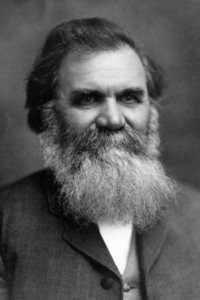
Welcome to the Blog
Welcome to the inaugural Atlas Health Therapy blog post! The purpose of this blog is to present the public with information and resources surrounding health, wellness, and performance. Various topics will be discussed with the goal set forth to empower you take control of your own health and strive towards optimal function and well being.
To begin, our chiropractor, Dr. Kevin Sommerfeldt, would like to give you a brief introduction to the chiropractic profession:
Introduction to Chiropractic Care
History

D.D. Palmer (1845-1913)
The chiropractic profession was founded in 1895 when D.D. Palmer performed the first chiropractic adjustment on Harvey Lillard, a partially deaf janitor. The story goes that Mr. Lillard had become partially deaf after bending forward and hearing a ‘pop’ in his back. D.D. Palmer noticed a lump between Mr. Lillard’s shoulder blades and offered to ‘rack his bone back into position’. After two treatments, Mr. Lillard had permanently regained most of his hearing.
While the original story of a chiropractic adjustment curing hearing loss may seem dubious and unverifiable, the fact remains that the health of the spine plays an integral role in overall health. The chiropractic profession has since evolved into a primary health care field that is backed by an ever increasing database of peer-reviewed scientific research.
Schooling
The average person that I talk to about the chiropractic profession tends to be unaware of the level of schooling required to be become a Doctor of Chiropractic. To become a chiropractor, one must complete a 4 year post-graduate program at an accredited chiropractic college. Typically, the first 3 years towards becoming a chiropractor consists of primarily academics, with the 4th and final year consisting of a year long internship. Personally, I did my Bachelor of Science in Kinesiology at the University of Victoria, followed by my Doctor of Chiropractic at the Canadian Memorial Chiropractic College. An interesting comparison of the different health professions can be found through the following link: https://prohealthsys.com/students/professional-comparison/

Canadian Memorial Chiropractic College (Toronto, ON)
Following schooling, chiropractors are required to pass national board examinations in order to become licensed in the state or province they wish to practice.
Role in Healthcare
A chiropractor can be defined as an expert in assessing, diagnosing, and treating conditions and dysfunctions of the neuromusculoskeletal system – that is to say, conditions that involve the nervous system, muscles, bones, joints, ligaments, tendons, fascia, etc. Chiropractors are often considered the leading experts in spinal health, but they are also trained and competent in managing conditions outside of the spine (rotator cuff tendinopathies and plantar fasciitis, as examples).

Instrument Assisted Soft Tissue Mobilization (i.e. Graston)
Within the chiropractic profession, you will find a wide variety of practice styles. Modern chiropractors tend to be more integrative in their treatment techniques, including chiropractic adjustments, joint mobilizations, soft tissue techniques (ex. ART or Graston), exercise and rehabilitation, patient education, and lifestyle advice/modification. Today you will find more chiropractors integrated within multi-disciplinary clinics and professional sports teams.
What to Expect

The first visit with your chiropractor will include a detailed interview focusing on your complaint and general health. The interview helps lead the chiropractor into the next step, which is the physical examination. During the physical examination, the chiropractor will guide the patient through a series of movements, conduct orthopedic tests, palpate for joint restriction and muscle tone, perform neurological tests, and any other special tests that may be relevant to your case. The goal of the physical examination is to help determine the potential cause/source of your pain or condition.
Following the physical examination, your chiropractor will discuss and explain his or her suspected diagnoses and propose a treatment plan. The treatment plan is developed collaboratively with you, the patient, with your goals and expectations taken into account.
Want to learn more about chiropractic in Canada and British Columbia? Check out the following advocacy bodies:
British Columbia Chiropractic Association
Canadian Chiropractic Association
Thank you for taking the time to read the first blog, and I look forward to creating many more!

Kevin Sommerfeldt, DC



